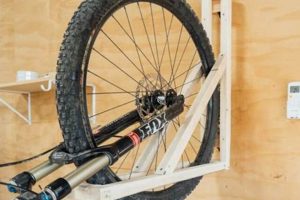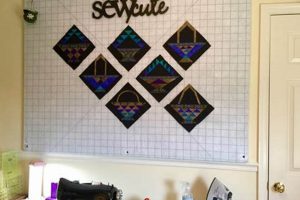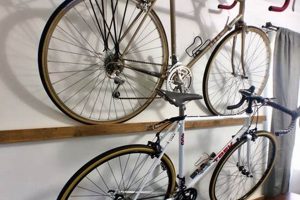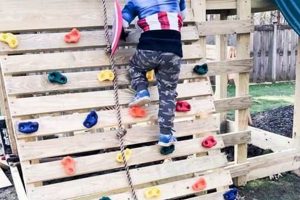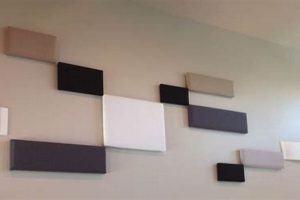A do-it-yourself project focused on creating a storage solution for footwear that is affixed to a vertical surface defines a specific category of home organization. This encompasses a range of designs, from simple shelves constructed from reclaimed wood to more elaborate systems utilizing metal brackets and wire racks, all intended to hold shoes and keep them off the floor.
Such a storage implementation maximizes available space, particularly in areas with limited square footage, such as entryways, hallways, or closets. Historically, resourceful homeowners have employed various methods to organize footwear, but the concept of elevating storage off the floor offers improved accessibility, enhanced aesthetics, and easier cleaning, contributing to a more organized and visually appealing living environment.
The following sections will delve into materials selection, design considerations, construction techniques, and installation procedures relevant to this type of organizational furniture. Further details will address factors such as load-bearing capacity, space optimization, and aesthetic integration with existing decor.
Tips for a Successful Wall-Mounted Footwear Organizer Project
Careful planning and precise execution are paramount when undertaking a do-it-yourself project for a wall-mounted footwear organizer. These tips provide guidance for a sturdy, functional, and aesthetically pleasing outcome.
Tip 1: Material Selection is Crucial: Choose materials appropriate for the anticipated load. Solid wood offers durability and aesthetic appeal, while metal provides strength and can be more suitable for heavier footwear. Consider moisture resistance for areas prone to dampness.
Tip 2: Accurate Measurement is Essential: Measure the available wall space precisely and account for the dimensions of the footwear collection. Ensure adequate spacing between shelves or racks to accommodate various shoe heights and sizes.
Tip 3: Prioritize Secure Mounting: Utilize appropriate wall anchors suitable for the wall type (drywall, plaster, concrete). Securely attach the organizer to wall studs whenever possible to maximize stability and weight-bearing capacity. Verify levelness during installation.
Tip 4: Design for Functionality and Accessibility: Design the organizer to facilitate easy access to shoes. Consider sloped shelves, open racks, or designated compartments for different types of footwear. Ensure adequate lighting for visibility.
Tip 5: Consider Ventilation: Design elements that promote airflow can help prevent moisture buildup and odor retention. Incorporate gaps between shelves or utilize breathable materials.
Tip 6: Finishing Enhances Durability and Aesthetics: Apply a protective finish to the organizer to enhance its durability and resistance to wear and tear. Select a finish that complements the surrounding decor and is easy to clean.
Tip 7: Regularly Inspect and Maintain: Periodically inspect the organizer for signs of wear or damage. Tighten any loose screws or hardware and address any structural issues promptly.
By adhering to these guidelines, a homeowner can create a durable and aesthetically pleasing storage solution that optimizes space and contributes to an organized living environment.
The final section of this article will address common challenges encountered during such projects and provide solutions for troubleshooting potential issues.
1. Material Selection
The selection of appropriate materials is a foundational element in the creation of a wall-mounted footwear organizer. This choice dictates the unit’s structural integrity, longevity, aesthetic appeal, and suitability for its intended environment. The following points elaborate on key facets of material selection in this context.
- Wood Type and Properties
The choice between hardwood and softwood significantly impacts the rack’s load-bearing capacity and resistance to wear. Hardwoods, such as oak or maple, offer superior durability and are suitable for heavier footwear collections, while softwoods, like pine, are lighter and more cost-effective but may be less resistant to scratches and dents. The wood’s moisture content is also critical; kiln-dried wood minimizes warping and cracking over time.
- Metal Composition and Gauge
Metal components, often used for brackets or frames, require careful consideration of alloy and gauge. Steel offers high strength and is ideal for supporting substantial weight, but is prone to rust if not properly coated. Aluminum is lighter and corrosion-resistant, but may have lower load-bearing capabilities. The gauge (thickness) of the metal directly influences its stiffness and ability to withstand bending or deformation under load.
- Composite Materials and Durability
Composite materials, such as plywood or MDF (Medium-Density Fiberboard), offer cost-effective alternatives to solid wood. High-quality plywood, with multiple layers and a durable veneer, can provide sufficient strength for lighter footwear storage. MDF is smooth and easy to paint, but is more susceptible to moisture damage and should be used in dry environments. Edge banding is essential to protect exposed edges of composite materials from chipping and moisture.
- Fasteners and Corrosion Resistance
The selection of fasteners, such as screws and bolts, is crucial for the stability and longevity of the structure. Screws made of stainless steel or coated with a corrosion-resistant finish are recommended for preventing rust and ensuring a secure connection, especially in humid environments. The type of screw (e.g., wood screw, drywall screw) should be appropriate for the materials being joined.
In summary, material selection for a wall-mounted footwear organizer involves a nuanced assessment of strength, weight, environmental factors, and aesthetic preferences. The optimal choice balances these considerations to create a storage solution that is both functional and visually appealing.
2. Space Optimization
Space optimization is a fundamental driver in the adoption and design of wall-mounted footwear storage. In residential environments, particularly those with limited square footage, efficient utilization of available space is paramount. The transition from floor-based to wall-mounted storage directly addresses this need, liberating valuable floor area and contributing to a less cluttered environment.
- Vertical Space Utilization
Wall-mounted units inherently exploit vertical space, which is often underutilized in homes. By extending storage upwards, rather than outwards, the footprint is minimized. This is particularly relevant in narrow hallways or entryways where floor space is at a premium. For example, a rack extending from floor to ceiling can house a significantly larger collection than a similarly sized floor-based alternative.
- Adaptability to Confined Spaces
These storage solutions can be customized to fit precisely within the dimensions of unconventional spaces, such as under staircases or within alcoves. This adaptability contrasts with pre-fabricated furniture, which may not conform to the unique constraints of a given area. The capacity to tailor dimensions maximizes storage potential in otherwise unusable areas.
- Floor Clearance and Accessibility
Raising the footwear off the floor facilitates easier cleaning and maintenance. Removing obstructions from the floor simplifies vacuuming or mopping, contributing to improved hygiene. Furthermore, wall-mounted units can be positioned at a convenient height, improving accessibility for users with mobility limitations.
- De-cluttering and Visual Order
Organizing footwear on a wall-mounted rack contributes to a less cluttered and more visually ordered environment. Shoes are consolidated and presented in a neat manner, reducing visual noise and promoting a sense of calm. This organizational benefit extends beyond aesthetics, facilitating easier retrieval and reducing the likelihood of misplaced items.
In conclusion, space optimization is an inherent advantage of wall-mounted footwear storage. Its capacity to utilize vertical space, adapt to confined areas, improve floor clearance, and contribute to visual order makes it a compelling solution for homeowners seeking to maximize the efficiency and aesthetic appeal of their living spaces.
3. Load Distribution
The structural integrity of any wall-mounted object, including footwear storage, hinges on the principle of load distribution. This concept dictates how weight is dispersed across the supporting structure and transferred to the wall itself. Inadequate consideration of load distribution in the construction of a do-it-yourself footwear rack can lead to structural failure, posing a safety hazard and damaging the wall.
- Anchor Point Strength and Spacing
The number, type, and spacing of anchor points are critical determinants of load distribution. Anchors must be selected based on the wall material (drywall, plaster, concrete) and the anticipated weight of the rack and its contents. Insufficient anchor points or inappropriate anchor types concentrate stress on specific areas, increasing the risk of pull-out. Proper spacing ensures a more even distribution of weight along the length of the rack, reducing stress on individual anchors. Stud finders can be used to locate wall studs for maximum support.
- Material Rigidity and Support Structure
The rigidity of the materials used in rack construction significantly impacts load distribution. Flexible materials, such as thin plywood or weak plastics, can deflect under load, concentrating stress on anchor points. A robust support structure, incorporating bracing and reinforcement, distributes weight more evenly across the frame. Utilizing thicker materials or adding internal supports enhances rigidity and improves load distribution.
- Weight Placement and Balancing
Uneven weight distribution on the rack exacerbates stress on specific anchor points. Placing heavier items towards the center or evenly distributing weight across the rack minimizes the risk of overloading specific sections. Angled shelves or dividers can prevent items from shifting and concentrating weight in one area. Regular adjustment of contents may be necessary to maintain balanced distribution.
- Wall Integrity and Condition
The condition of the wall itself influences its capacity to bear weight. Damaged or deteriorated walls, such as those with water damage or crumbling plaster, offer compromised support. Reinforcing damaged areas or selecting alternative mounting locations with sound structural integrity is crucial. Considering the wall’s composition and condition is an integral part of planning and execution.
The foregoing points illustrate the interconnectedness of design, material selection, and installation technique in achieving adequate load distribution for a wall-mounted footwear organizer. A thorough understanding of these principles is indispensable for constructing a safe, functional, and long-lasting storage solution.
4. Aesthetic Integration
Aesthetic integration, in the context of do-it-yourself wall-mounted footwear storage, transcends mere functionality, becoming a critical factor in harmonizing the storage solution with the overall visual environment of a space. The goal is to create a storage unit that not only organizes footwear but also complements and enhances the existing dcor, rather than detracting from it.
- Material Palette and Color Coordination
The selection of materials and colors significantly influences the visual impact of the storage unit. Choosing materials that complement existing furniture, trim, or wall colors creates a cohesive aesthetic. For instance, using reclaimed wood for a rustic-themed room or opting for sleek metal and neutral tones in a modern setting ensures visual harmony. Mismatched materials or clashing colors can disrupt the visual flow and detract from the overall design.
- Design Style and Architectural Consistency
The design style of the footwear rack should align with the architectural style of the room. A minimalist design with clean lines is appropriate for contemporary spaces, while a more ornate or detailed design may be suitable for traditional or Victorian-style rooms. Incorporating design elements that mirror existing architectural features, such as molding or paneling, can further enhance the integration.
- Scale and Proportion within the Space
The size and proportions of the storage unit must be carefully considered in relation to the dimensions of the wall and the overall space. A rack that is too large can overwhelm a small room, while one that is too small may appear insignificant. Maintaining visual balance and ensuring that the unit is proportional to the surrounding elements contributes to a harmonious aesthetic. Consideration should be given to the unit’s depth, height, and width, ensuring it fits comfortably within the available space.
- Hardware and Finishing Details
The selection of hardware, such as screws, brackets, and handles (if applicable), can significantly impact the overall aesthetic. Choosing hardware that complements the materials and design style of the rack enhances its visual appeal. Similarly, the finishing details, such as paint, stain, or varnish, should be selected to achieve the desired aesthetic effect. A well-executed finish protects the materials and enhances the overall visual quality of the storage unit.
These considerations collectively contribute to the successful aesthetic integration of a do-it-yourself wall-mounted footwear storage solution. By carefully selecting materials, design styles, scale, and finishing details, a homeowner can create a storage unit that is not only functional but also aesthetically pleasing and seamlessly integrated into the existing environment, enhancing the overall visual appeal of the space.
5. Mounting Security
Mounting security represents a critical element in the successful implementation of a do-it-yourself wall-mounted shoe rack. Insufficiently secured racks present a significant safety hazard, risking collapse and potential injury or property damage. The relationship between secure mounting and the overall utility of the rack is direct: inadequate mounting negates any organizational or aesthetic benefits, rendering the project a failure. For example, a rack constructed from solid wood, designed to hold multiple pairs of heavy boots, will fail to function if mounted with inadequate drywall anchors, leading to eventual detachment from the wall.
The principles of secure mounting involve several factors. Wall material dictates anchor type. Drywall, plaster, brick, and concrete each require specific anchors designed to expand, grip, or physically interlock with the substrate. Load-bearing capacity is also paramount; anchors must be rated to support the weight of the rack plus its maximum potential load. Incorrect anchor selection causes stress concentration, leading to pullout and eventual failure. Furthermore, utilizing wall studs for direct attachment provides superior holding strength compared to relying solely on anchors within drywall or plaster. Regularly inspecting the mounting hardware for loosening or signs of stress is essential for preventative maintenance.
In summary, prioritizing mounting security is paramount for any do-it-yourself wall-mounted shoe rack project. It is not merely an installation step but an integral aspect of the rack’s design and long-term functionality. Failure to address this aspect adequately introduces unacceptable safety risks and compromises the project’s ultimate success. Homeowners should thoroughly research appropriate mounting techniques and hardware before commencing construction to ensure a safe and durable storage solution.
Frequently Asked Questions
The following addresses common inquiries regarding the design, construction, and installation of do-it-yourself wall-mounted footwear storage solutions.
Question 1: What is the most critical factor in ensuring the long-term stability of a wall-mounted shoe rack?
The most critical factor is the selection and proper installation of wall anchors suitable for the wall material (drywall, plaster, concrete) and capable of supporting the rack’s maximum anticipated weight. Utilizing wall studs for direct attachment offers the most secure solution.
Question 2: How does material selection impact the overall cost and durability?
Hardwoods, such as oak or maple, generally increase material costs but provide superior durability and load-bearing capacity. Softwoods, like pine, are more economical but may be less resistant to wear and tear. Metal components offer high strength but may require protective coatings to prevent corrosion. Composite materials offer a balance of cost and durability but may be susceptible to moisture damage.
Question 3: What design considerations should be prioritized when space is limited?
Prioritize vertical space utilization. Design the rack to extend upwards, maximizing storage capacity within a smaller footprint. Consider adjustable shelves or racks to accommodate various shoe heights. Ensure adequate spacing between shelves for easy access and ventilation.
Question 4: How can aesthetic integration be achieved with existing decor?
Select materials and colors that complement existing furniture, trim, or wall colors. Consider the design style of the room and choose a rack design that aligns with that style. Pay attention to scale and proportion, ensuring the rack is visually balanced within the space. Choose hardware and finishing details that enhance the overall aesthetic.
Question 5: What safety precautions should be observed during construction and installation?
Wear appropriate safety gear, including eye protection and gloves. Use power tools with caution and follow manufacturer’s instructions. Ensure the work area is well-ventilated. Securely support the rack during installation to prevent accidental falls. Verify the rack is level before securing it to the wall.
Question 6: How can potential problems, such as sagging or detachment from the wall, be prevented?
Ensure adequate load distribution by using multiple anchor points and a robust support structure. Avoid overloading the rack with excessive weight. Regularly inspect the mounting hardware for loosening or signs of stress. Reinforce damaged areas of the wall before installation. Use appropriate construction techniques to prevent sagging.
These frequently asked questions underscore the importance of careful planning, material selection, and execution in the construction and installation of a do-it-yourself wall-mounted footwear storage solution. Prioritizing safety, functionality, and aesthetics ensures a successful project.
The subsequent section will address advanced design considerations for more complex storage solutions.
Conclusion
This examination of the concept of “diy wall mounted shoe rack” has addressed core considerations ranging from material selection and space optimization to load distribution, aesthetic integration, and mounting security. Each of these elements contributes to the creation of a functional and aesthetically pleasing storage solution. Neglecting any of these aspects compromises the overall utility and safety of the finished unit. The design must align with structural integrity and weight distribution, alongside with the aesthetics and function.
The information presented serves as a foundation for constructing such a storage solution with increased knowledge and awareness. By adhering to the principles outlined, homeowners can maximize the value of their investment of time and resources, creating a long-lasting and effective organizational tool for their living space. Future innovation in this area can focus to the sustainability by re-using recycle material for the environmental aspects.


